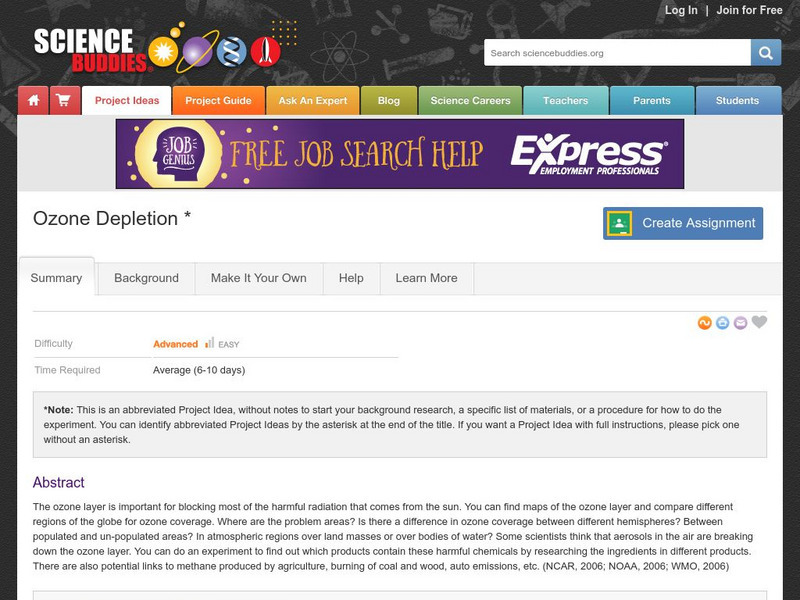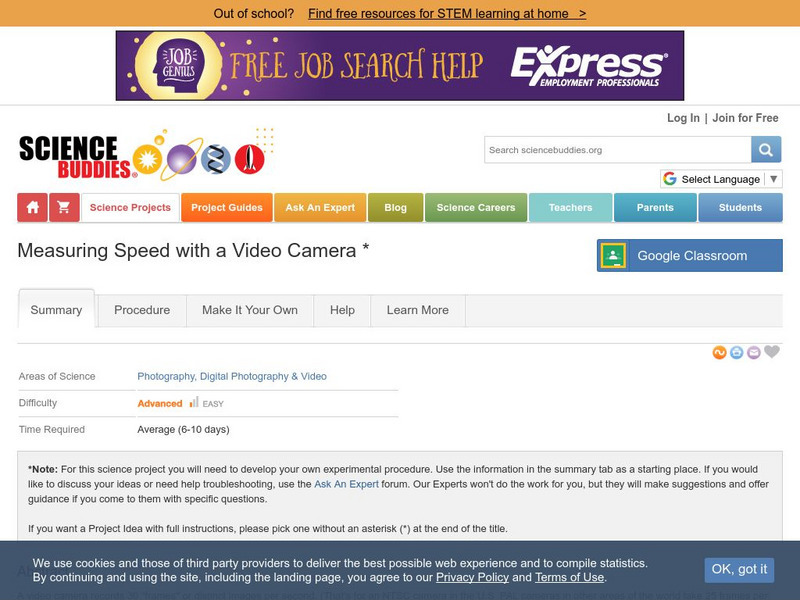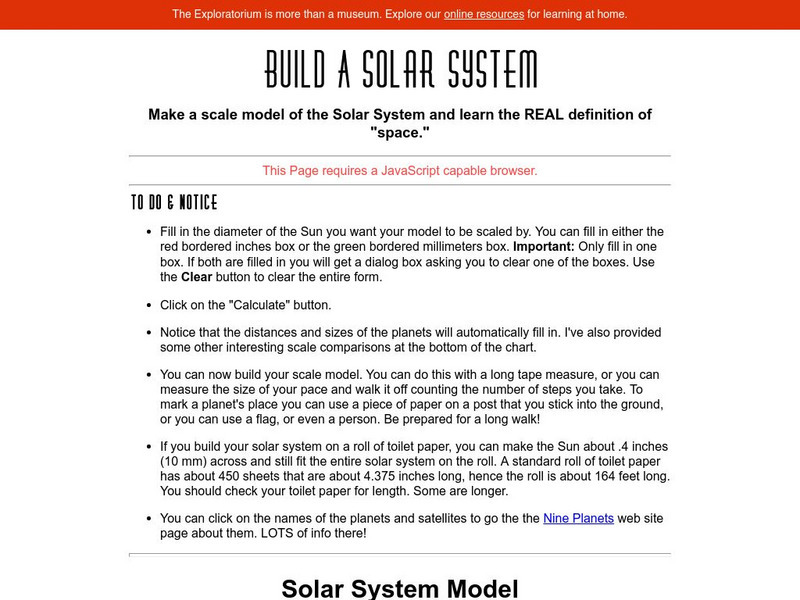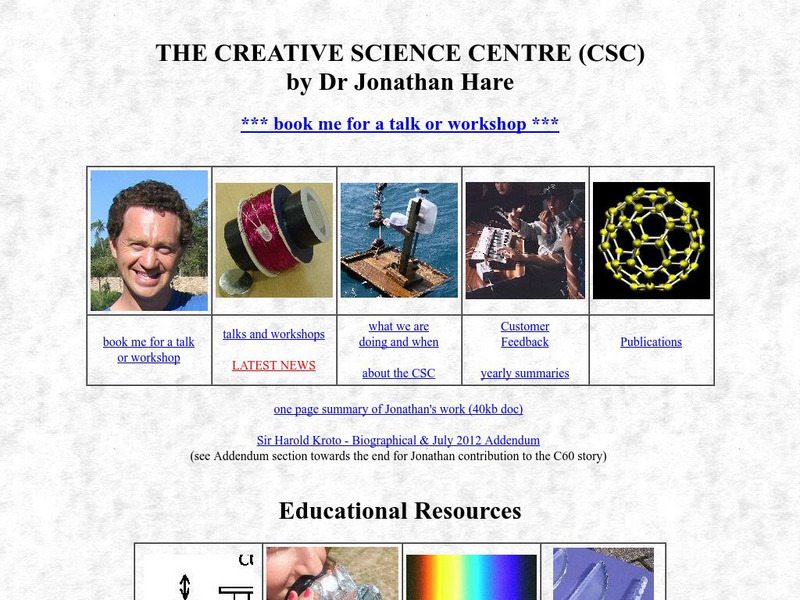Science Buddies
Science Buddies: Measuring Speed of Moving Objects With Stroboscopic Photography
A strobe light can illuminate an entire room in just tens of microseconds. Inexpensive strobe lights can flash up to 10 or 20 times per second. This project shows you how to use stroboscopic photography to analyze motion.
Science Buddies
Science Buddies: Ozone Depletion
The ozone layer is important for blocking most of the harmful radiation that comes from the sun. You can find maps of the ozone layer and compare different regions of the globe for ozone coverage. Some scientists think that aerosols in...
Science Buddies
Science Buddies: Porosity
Soils are made of particles of different types and sizes. The space between particles is called pore space. Pore space determines the amount of water that a given volume of soil can hold. Porosity is the percentage of the total volume of...
Science Buddies
Science Buddies: Composting and Vermiculture
Make your own fertile soil using kitchen scraps, manure, leaves, grass clippings, and other compostable materials. Which materials make the best compost?
Science Buddies
Science Buddies: Measuring Velocity With a Video Camera
A video camera records 30 "frames" or distinct images per second. (That's for an NTSC camera in the U.S. PAL cameras in other areas of the world take 25 frames per second.) You can use this fact to time events and measure velocity. One...
Science Buddies
Science Buddies: Camera 'Shakes'
You can compare the picture quality for photos taken at different shutter speeds with the camera handheld vs. with the camera on a tripod. (This is best done with a camera that has manual exposure control.)
Science Buddies
Science Buddies: Digital Image Processing
Students who are mathematically inclined can use the student version of a program like MatLab or Mathematica to convert a digital image into numbers, then perform operations such as sharpening or special effects. This is a great way to...
Science Buddies
Science Buddies: Image Compression
Compare the strengths and weaknesses of different digital image formats. How does the amount of compression affect a JPEG image? What happens when you save a JPEG image multiple times?
Science Buddies
Science Buddies: Disinfectants
This experiment asks you to compare different types of cleaning agents. Household cleaning products, like bleach or Lysol, are included to see which ones kill the most bacteria. Different brands of antibacterial hand soap or dish soap...
Science Buddies
Science Buddies: Natural Antimicrobial Agents
This abstract asks you to discover what sources you can test for antimicrobial action by culturing bacteria in the presence of an extract from a source you hypothesize to have antimicrobial properties. Antimicrobial properties have been...
Science Buddies
Science Buddies: Cinnamon Gum and Mouth Microbes
A scientific study has shown that chewing Big Red Gum reduces mouth microbes. Cinnamon oil in gum is a natural defense against mouth bacteria that cause tooth decay and bad breath. Conduct an experiment to compare products with cinnamon...
Science Buddies
Science Buddies: Beats
Systematically explore different frequency combinations in this experiment provided by Science Buddies. You will use your computer to create sound files to play pure tones on your computer, one frequency in the left channel, and another...
Science Buddies
Science Buddies: Humic Acid and the Optimum Soil for Plants
Humic acid is touted as an organic soil additive to improve plant growth by multiple means. Does it really work? Here's how you can find out.
Creative Science Centre
Creative Science Centre: Simple High Temperature Light Bulb Thermometer
A very simple electrical resistance thermometer is described that can be built, calibrated and tested in a school laboratory at virtually no cost. With it, flames, focused sunlight and other high temperature sources can be probed. The...
Science Buddies
Science Buddies: Dots Per Inch (Dpi) and Image Quality
Your digital photo comprises a certain number of dots in the x and y directions. What happens to the print image quality as you "stretch" those dots out to larger and larger pictures? (Note: This experiment studies the dots per inch in...
Science Buddies
Science Buddies: Steps of the Scientific Method
An explanation of the scientific method for young scholars preparing a science fair project, or any science project. Each step of the process is supported with additional helpful information and advice.
University of Washington
Washington U: Model for Conducting Scientific Research
This page outlines the scientific method, step by step.
American Museum of Natural History
American Museum of Natural History: O Logy: Stuff to Do: Buried Bones
A how-to science project with instructions to make a complete dinosaur bone dig site burying chicken bones in plaster of Paris. Click on the starred words to learn more about the topic.
Cornell Lab of Ornithology
Habitat Network: Flower Beds
Learn how to provide appropriate flowering plants to increase diversity in an environment.
Science Made Simple
Science Made Simple: Why Is the Sky Blue?
This website has three different projects from which to choose on the topic of why the sky is blue. Also, you can scroll up to learn more about why the sky is blue.
Exploratorium
Exploratorium: Build a Solar System
Make a scale model of the Solar System and learn the REAL definition of "space." You tell it how large to make the sun (in inches or millimeters) and the page will do all of the calculations for your scale model solar system and provide...
Science Bob Pflugfelder
Science Bob: Bend Water With Static Electricity!
Contains a procedure for illustrating electrostatic attraction between opposite charges by causing a thin stream of water to bend. The site gives a brief discussion of static electricity, as well.
Cengage Learning
Cengage Learning: Project Based Learning: Egg Drop Experiment
Students are challenged to design a way to drop a raw egg from varying heights without letting the egg break. Creative thinking and evaluation of results are critical to the project.
Creative Science Centre
Creative Science Centre
This comprehensive resource has a collection of creative science ideas and challenges. The goal is to guide teachers and students toward developing more creative science projects.






















